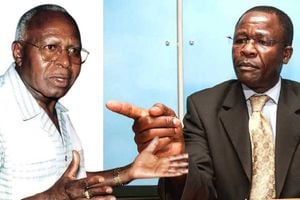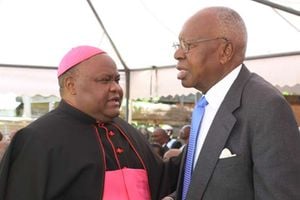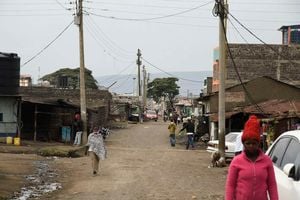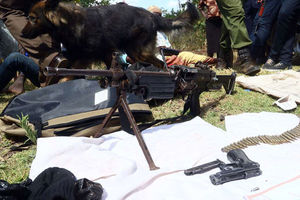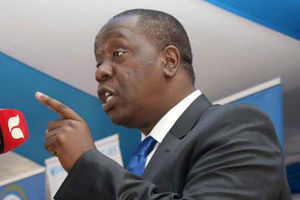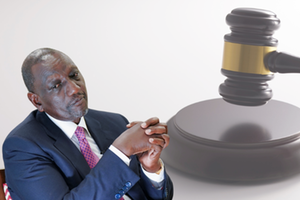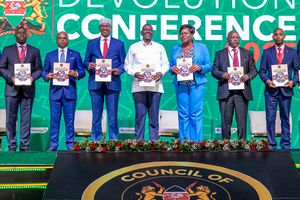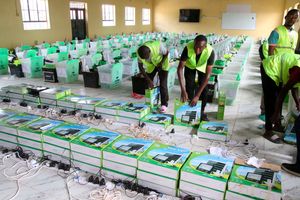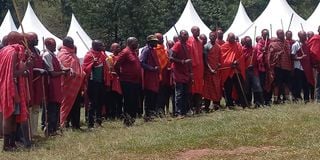
A group of mourners who were introduced as Chinkororo during the burial of former Bonchari MP John Zebedeo Opore on November 9 ,2024.
In Gusii land, mainly Kisii and Nyamira counties, the mention of Chinkororo evokes mental images of bold, energetic and swift young men ready for combat whenever the community is under threat.
The Abagusii is an East African ethnic group with diverse origins, with the majority of the population originating from the pre-existing Neolithic Agro-pastoralist and hunter-gatherer inhabitants of present-day Kenya— particularly former Nyanza and Rift Valley provinces.
Among the Abagusii, a Bantu ethnic group, Chinkororo is a traditional militia that used to deploy whenever inter-ethnic violence broke out along the common border with the Kipsigis, Maasai and at times the Luos.
Although outlawed by the government for allegedly engaging in criminal activities, the group resurfaces in Kisii from time to time, depending on the occasion and prevailing political climate.
On November 9, a group of men belonging to the group caused a stir during the burial of former Bonchari MP Zebedeo Opore at Nyamiobo village in Kisii South, a few kilometres from the common border of Abagusii and the Luo of Asumbi.
For a moment, the funeral ceremony was turned into a theatre of the absurd after the gang was paraded, ostensibly to pay their last respects to the deceased, whom they claimed was one of their fathers and benefactors.
“We are the Chinkororo and have come here to pay our last homage to the man who was among those leaders that funded our past activities,” declared the spokesperson of the group, who identified himself as Keraka Oyondi.
Donning red Maasai shukas and armed with wooden clubs and long sticks, the militia marched in front of the mourners making war sounds as though they were challenging their enemies to a duel.
They spotted red painted hair and jumped up and down like the Maasai Morans raring for a fight.
“Among us here are professionals, like teachers and other experts who serve our community in different capacities. The late Opore and other former MPs from Gusii funded us,” said Keraka.
He mentioned several sitting lawmakers, former MPs and ministers, including Simeon Nyachae and Henry Obwocha (both deceased), saying they bought them the uniforms they were wearing.
“The deceased (Opore) contributed money and the uniforms you can see we are wearing,” said Mr Keraka.
Land jobs
Mr Keraka said the former MPs also influenced the employment of their members in government. He claimed Kisii leaders had helped members of Chinkororo land jobs in the police service, education and health sectors
Sources in the area told the Nation that the gang was transported from Ramasha area of Nyaribari Masaba and their mission was to allegedly provide security at the funeral.
Their presence sparked panic because the funeral had been anticipated to be a tense one after a Kisii court ordered that a woman who had claimed to have had children with Opore be allowed to attend the funeral under police protection.
This was curious because formal security officials were present under the command of Kisii County Police Commander Charles Kases.
The funeral was attended by leaders from the region— including the incumbent MP, Dr Charles Onchoke, Governor Simba Arati, Senator Richard Onyonka, Nominated Senator Essy Okenyuri, MPs Obadiah Baringo (Bomachoge Borabu), Steve Mogaka (West Mugirango) and other leaders from Kisii and Nyamira.
Authorities have, however, remained silent on this latest emergence of the outlawed group. They did not respond to questions by the Nation on the appearance of the armed men at the burial.
A source who spoke on condition of anonymity for fear of being attacked by the militia said villagers were surprised when the chairman of the funeral committee announced that members of Chinkororo were present, and should be allowed to pay their last respects to the deceased.
“Although there were disagreements in the family about whether to accept the woman claiming she was Opore’s wife, we didn’t expect Chinkororo at the funeral,” said the source.
Among the Abagusii, Chinkororo (singular Enkororo) were initially a respected tribal “army” that protected the community from external aggression.
However, in the late 1990s and early 2000s, some Kisii politicians turned the group into a criminal and political militia, which combined forces with yet another proscribed ragtag gang, “Amachuma” to terrorise their political opponents.
During the infamous politically instigated tribal clashes of 1997, the Chinkororo were heavily relied upon to neutralise Maasai morans along the Kisii borders of Kiango, Geteri, Ramasha, Ekona ya Ngare and Nyangusu.
The Chinkororosalso engaged the Kalenjin warriors along the Kisii-Kipsigis border in Chepilati, and other parts of North Mugirango and Borabu.
The group is said to be notorious for attacking elected leaders opposed to those who fund them.
During a political rally in South Mugirango, the late Nyachae literally unleashed the gang on the then Eldoret North MP William Ruto — now President, Omingo Magara, then South Mugirango MP, and former Bobasi MP Chris Obure, injuring them seriously.
The politicians were accused of being in the opposition, and that their attempt to join Nyanchae’s rally was viewed as open provocation.
They threatened to set the politicians' chopper on fire and it was all chaos as police watched in acquiescence, the same way they did on November 9 at Opore’s home.
During the anti-government protests that were led by some Azimio leaders in Kisii, a well-known powerful politician who holds a key docket in government unleashed Chinkororo to counter the peaceful protesters.
They came up to Kisii town and were seen armed with bows and arrows as they hunted down the protesters.
Overpowered
At some point, they were overpowered and chased back to South Mugirango where they had come from. One of them was killed.
People armed with bows and arrows have also been spotted at various functions that were rocked by chaos in Kisii.
One such function is that which was graced by Kisii Woman Representative Dorice Aburi in South Mugirango.
The men were armed with machetes, clubs, and bows when they stormed the function, leaving folks including People Living with Disabilities (PLwDs) injured, shaken and dumbfounded.
Some journalists got roughed up in the chaos that broke out at Nyakeyo Primary School.
Speaking in Kirinyaga during the opening of the Kerugoya Referral Hospital in June last year, President Ruto warned that his government would not allow the resurgence of criminal gangs in the country.
“We as the government will not allow illegal groups to be created. I want to tell the leaders who are trying to signal to us that they want to return Mungiki so they can start using bhang and other drugs, and if they feel it is that important first take your children to be among them,” he said.
Findings of research published in the East African Review in 2021 stated that the ban on Chinkororo as a criminal unit generated debates on the identity of the unit.
“To some, Chinkororo included traditional Gusii warriors and was a security wing of the Abagusii," the report, titled The Men Watching Our Borders: The Evolution, Identity and Tenacity of Chinkororoin Gusii, Kenya.
"It aimed to fill the gap left by the government along the borders, especially when it came to cattle raiding by neighbouring Kalenjin and Maasai communities," the article says in its introduction.
"Chinkororo was variedly tagged names such as a vigilante, militia, and a criminal gang affiliated to the Abagusii community."
The apparent resurgence of the group, despite an existing ban, has left Kenyans wondering who between the government and Chinkororo is in charge of security in Gusii land.

